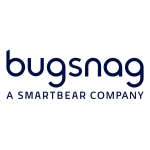
Bugsnag Application Stability Index Report Reveals Direct Correlation with App Store Ratings and Accelerated Release Cadences
Bugsnag’s findings show that mobile app stability falls short of 99.99% as it remains critical for business growth and gaining market share
SAN FRANCISCO–(BUSINESS WIRE)–Today Bugsnag, a SmartBear company and an application stability management pioneer, unveiled its second annual Application Stability Index (ASI) report, “Characteristics of Leading Mobile Apps.” As a key indicator of user experience, app stability is a vital business metric encompassing conversion, engagement, and retention, all of which are tied to revenue and business growth. Bugsnag’s latest ASI report helps organizations understand how their app is performing compared to others and what level of stability it needs to achieve to be a leader in its industry. The ASI revealed that just a 1% lower stability score can lead to a drop of almost 1 whole star in the app stores.
Mobile apps are powering an increasing number of customer interactions, making them more important than ever for business growth. Recent data from App Annie found that users spent $34 billion on apps in Q2 of 2021, shattering last year’s Q2 record by $7 billion. Users have high expectations from their mobile apps, like superior stability (meaning how often an app crashes), speed and availability of new capabilities and content. To help organizations understand how their app compares to other leading mobile apps, Bugsnag has compiled industry benchmarks on how stability impacts critical business factors, including app store ratings, stability, loyalty, and release frequency trends.
The ASI also analyzes app stability in industry verticals such as B2B SaaS, eCommerce, Consumer Goods, Finance & Banking, Gaming, Technology, and Travel & Hospitality and ranks them in categories such as Trailblazers (high stability), Old Faithfuls (medium stability) and A Dime a Dozen (low stability). Key findings include:
-
Just a 1% lower stability score can lead to a drop of almost 1 whole star in the app stores.
Users rate apps on the Google Play and Apple App Stores based on their overall experience with factors such as usefulness, design, engagement and stability. While the median stability across analyzed apps within the report fell at 99.8%, more stable apps were found to drive more exceptional user experiences, maximize retention, and build competitive advantage, resulting in higher ratings. Apps that achieve more 9s in their stability score have higher app store ratings.
-
App stability reflects the value and volume of mobile app interactions.
Mobile app stability represents the quality and quantity of user interactions. In other words, app stability measures how successful an app experience is and how many times users interact with it. App stability, while technically a calculation of crash-free sessions, is also impacted by business decisions. More specifically, it is influenced by customer loyalty and product pricing, which often follow industry norms. Product and pricing models may incentivize engineering teams differently in terms of how they balance bug fixes with feature releases.
-
Software engineers are adopting a weekly release cadence to replace the bi-weekly norm.
Developers update their apps regularly to deliver new features and address software bugs. Bi-weekly releases were once industry standard, but data across industries indicates that apps are being updated with a new version on average four times within a thirty-day time span. Strategies like release progressions and feature flags are helping teams build more confidence in developing and shipping new features to users quickly.
“The results of our second ASI report highlight the need for better proactive error monitoring and stability management to help engineering teams build healthier apps that deliver superior customer experiences,” said James Smith, SVP of the Bugsnag Product Group at SmartBear. “When developer organizations can effectively manage and improve the stability of their apps, they are able to achieve higher app store ratings, increase release frequency without sacrificing quality, and assess the health of their apps compared to peers in their industry.”
Bugsnag’s ASI report also highlights how each industry approaches the different factors that affect stability. Apps in an industry that tends to attract millions of users with typically low customer loyalty may tend to prioritize building new features faster than keeping up with bugs. Customer loyalty in this sense is inversely related to fixing bugs (boosting stability). On the other hand, apps that tend to serve a niche audience and could be priced higher, such as a B2B workflow app, may want to strike a balance between new features and fixing bugs where stability is top of mind. In this way, price perhaps reveals itself to be inversely related to introducing bugs (lowering stability).
About the Bugsnag Application Stability Index Report
The Bugsnag Application Stability Index Report is developed by analyzing data from mobile apps using Bugsnag’s Application Stability Management platform in 2021. Data studied includes 30-day stability scores based on actual mobile app sessions, number of app releases in 30 days, and publicly available Google Play and Apple App Store ratings. To view the full report, please visit: https://www.bugsnag.com/research/characteristics-of-leading-mobile-apps.
About SmartBear
At SmartBear, we focus on your one priority that never changes: quality. We know delivering quality software over and over is complicated. So our tools are built to streamline your DevOps processes while seamlessly working with the products you use – and will use. Whether it’s TestComplete, Swagger, ReadyAPI, Cucumber, Zephyr, Bugsnag, or one of our other tools, we span from test automation, API lifecycle, collaboration, performance testing, test management, app stability and error monitoring, and more. Whichever you need, they’re easy to try, easy to buy, and easy to integrate. We’re used by 16 million developers, testers, and operations engineers at 24,000+ organizations – including world-renowned innovators like Adobe, JetBlue, FedEx, and Microsoft. Wherever you’re going, we’ll help you get there. Learn more at smartbear.com, or follow us on LinkedIn, Twitter, or Facebook.
Contacts
Jordan Tewell
10Fold for Bugsnag
Email: Bugsnag@10fold.com
Web: bugsnag.com
